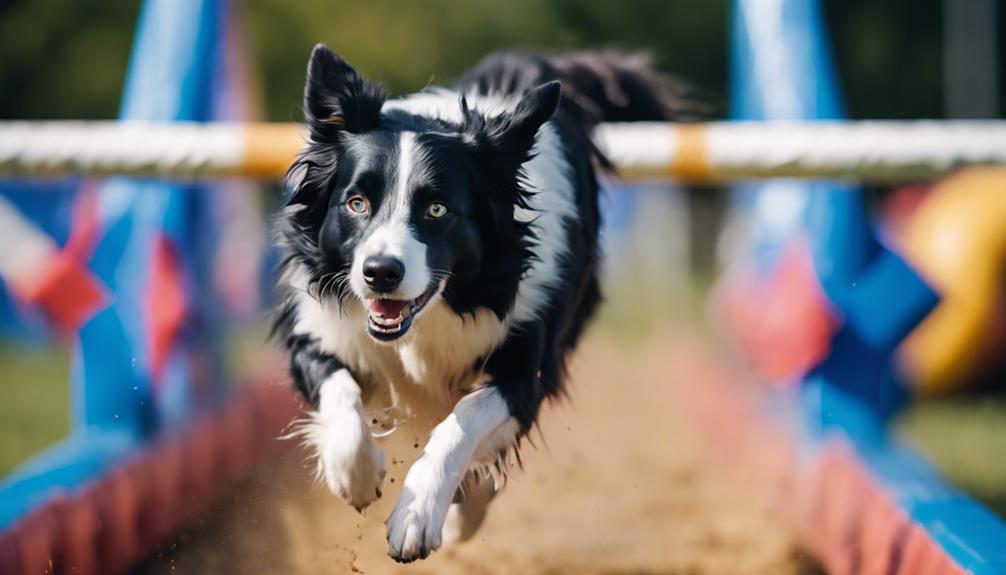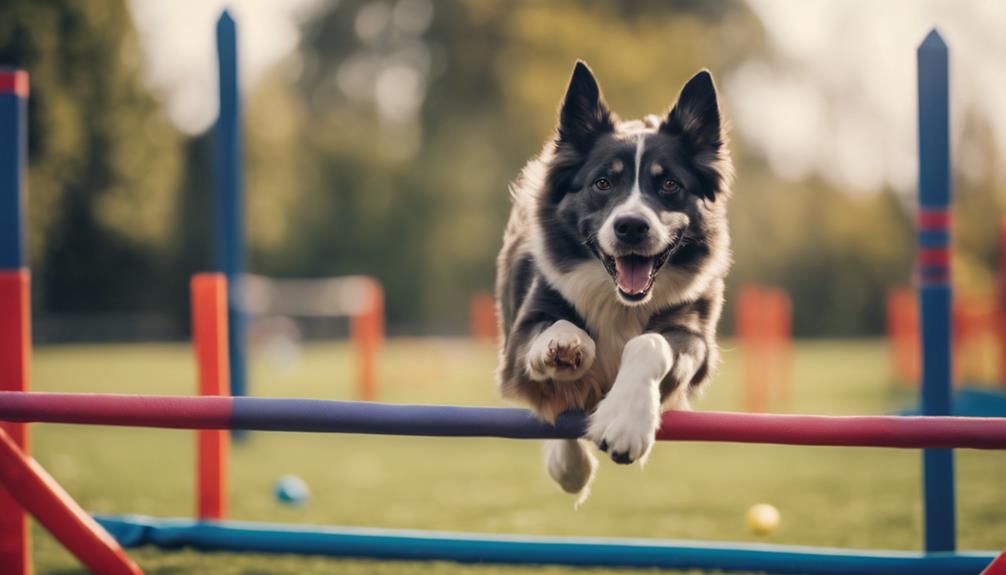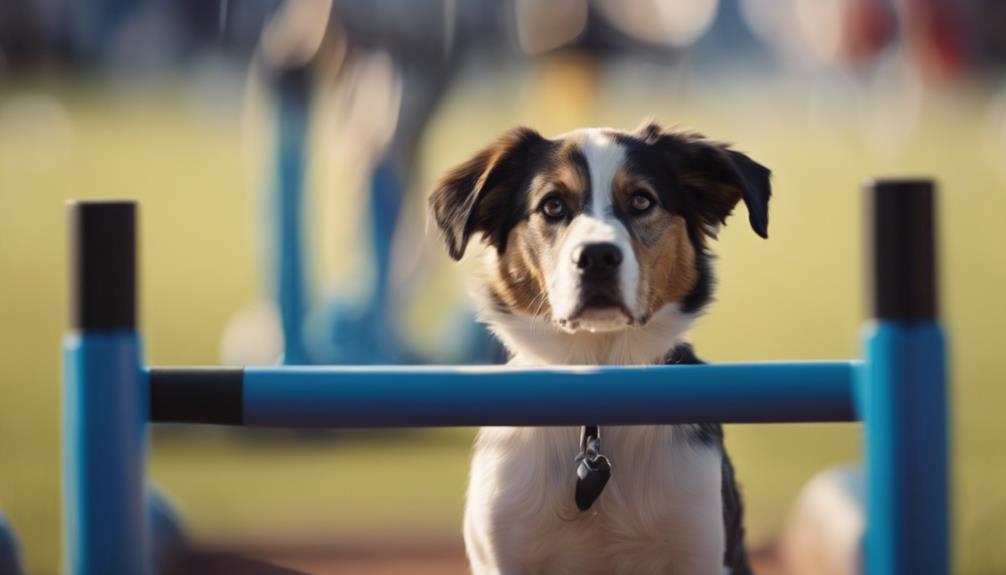Dog agility training is a multifaceted activity that holds advantages beyond just physical exercise for dogs. The mental stimulation and enhanced obedience resulting from participation are noteworthy aspects of this training regimen. However, the benefits extend further to include improved sociability and behavior management in dogs.
To fully appreciate the impact of agility training on canine companions, a deeper exploration into the intricacies of this sport and its practical implementation is required. Understanding the initial steps to commence this journey with your dog is crucial for a successful experience.
Key Takeaways
- Dog agility training provides physical and mental exercise for dogs, reducing boredom-related behaviors.
- Engaging in agility boosts sociability and confidence in dogs, allowing interaction with new people and pets.
- Agility is suitable for all dog breeds, offering opportunities for mixed breeds and rescues to compete.
- Starting agility requires basic obedience training and joining clubs for guidance and practice courses.
Physical and Mental Exercise Benefits
Engaging in dog agility training provides canines with a stimulating combination of physical activity and mental challenges that contribute to their overall well-being and development. Physical exercise in agility training helps dogs improve their strength, endurance, and flexibility. Jumping over hurdles, weaving through poles, and navigating ramps enhance their coordination and agility.
Additionally, the mental stimulation involved in learning new cues and problem-solving tasks sharpens their cognitive abilities. This combination of physical and mental exercise not only keeps dogs physically fit but also helps prevent boredom-related behaviors.
Boredom Reduction and Behavior Improvement
In addition to the physical and mental exercise benefits discussed previously, dog agility training plays a crucial role in reducing boredom-related behaviors and improving overall behavior in canines. This form of training provides mental stimulation and a constructive outlet for energy, addressing common behavioral issues.
Key benefits include:
- Boredom Reduction: Agility training keeps dogs mentally engaged and physically active, reducing tendencies towards destructive behaviors born out of boredom.
- Behavior Improvement: By learning to follow cues and navigate obstacles, dogs develop better focus, impulse control, and obedience, leading to improved behavior both during training sessions and in everyday life.
- Bond Strengthening: The training process enhances the bond between the dog and the owner, fostering trust and communication through shared activities.
Mental Engagement and Learning Opportunities

For dogs participating in agility training, mental engagement and learning opportunities are essential components that contribute to their overall well-being and development. Agility courses challenge dogs to think quickly, problem-solve, and follow cues, which can enhance their cognitive abilities and keep their minds sharp. This mental stimulation is crucial for preventing boredom and fostering a sense of accomplishment in dogs. Additionally, agility training provides valuable learning opportunities as dogs master new skills and refine existing ones. Whether it's navigating obstacles or responding to commands, each training session offers a chance for dogs to learn and grow.
| Mental Engagement and Learning Opportunities | |
|---|---|
| Enhances cognitive abilities | Keeps minds sharp |
| Prevents boredom | Fosters accomplishment |
| Challenges problem-solving skills | Offers learning opportunities |
Sociability and Confidence Boost
How does dog agility training contribute to the enhancement of sociability and confidence in dogs?
- Social Interaction: Agility training exposes dogs to new environments, other dogs, and people, fostering socialization skills.
- Building Confidence: Overcoming obstacles and mastering agility courses boosts a dog's self-assurance and confidence in their abilities.
- Trust Development: Working closely with their owner or handler during training strengthens the bond and trust between them, leading to increased confidence in various situations.
Through these elements, dog agility training goes beyond physical exercise, providing a holistic approach to enhancing a dog's sociability and confidence levels.
Agility Suitability Across Dog Breeds

When considering dog agility training, the suitability across various dog breeds is influenced by their inherent characteristics and physical abilities. While herding breeds like border collies are known for excelling in agility due to their intelligence and athleticism, dogs of all breeds, including Chihuahuas and Siberian huskies, can participate in this activity.
Competitors in agility competitions come from diverse backgrounds, including mixed breeds and rescue dogs, showcasing the inclusivity of the sport. During competitions, dogs are grouped based on experience and height, with adjustments made for senior dogs to ensure fair competition.
Understanding the unique traits and capabilities of different breeds can help handlers tailor training methods to suit their dog's individual needs for successful agility participation.
Equipment Accessibility and DIY Options
Considering the essential role of equipment in dog agility training, accessibility to specialized gear and do-it-yourself (DIY) options plays a crucial part in facilitating the practice for handlers and their canine companions. When embarking on agility training, it's beneficial to have various equipment readily available. Here are some key points to consider:
- Commercial Agility Equipment: Investing in professionally made agility gear such as tunnels, jumps, and weave poles ensures durability and standardization.
- DIY Options: Utilizing household items like PVC pipes, cardboard boxes, and cones can serve as makeshift agility obstacles for training purposes.
- Mock Courses: Setting up mock agility courses at home allows for regular practice and skill development in a familiar environment.
Dog Training Readiness Checklist

A comprehensive assessment of your dog's readiness for training is essential before embarking on a dog agility program. Begin by ensuring your dog is in good physical health, free from any injuries or conditions that may be exacerbated by agility training.
Evaluate your dog's temperament to gauge their willingness to learn and follow instructions. Basic obedience skills like responding to commands and being comfortable around other dogs are crucial.
Consider your dog's age and energy levels, as agility training can be physically demanding. It's also important to assess your own commitment and availability for consistent training sessions.
Finding Resources and Joining Clubs
To delve into the world of dog agility training effectively, aspiring enthusiasts should prioritize locating valuable resources and engaging with local clubs.
When seeking to expand your knowledge and skills in dog agility training, consider the following steps:
- Research Online: Utilize reputable websites, forums, and social media groups dedicated to dog agility training to gather information, tips, and advice from experienced trainers and enthusiasts.
- Attend Local Events: Visit agility competitions, workshops, or training demonstrations in your area to observe training techniques, interact with trainers, and network with fellow agility enthusiasts.
- Join Agility Clubs: Joining local dog agility clubs provides access to training facilities, structured classes, experienced instructors, and a supportive community of like-minded individuals passionate about agility training.
Conclusion
In conclusion, dog agility training offers a multitude of benefits for dogs, including physical exercise, mental stimulation, and improved behavior. Engaging in agility exercises can help reduce boredom and foster sociability in dogs, while also providing opportunities for learning and growth.
With the right resources and training readiness, owners can embark on this rewarding journey with their furry companions and strengthen their bond through the exciting sport of agility training.




